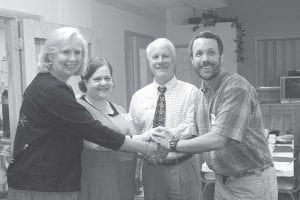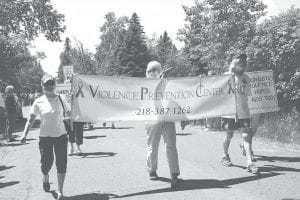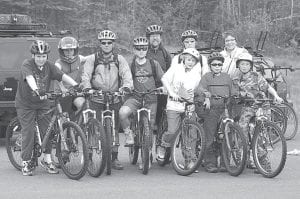How connected do residents of Cook County feel to their community? How involved are they, and do they believe that they can make a difference here?
Two projects within the last year and a half have investigated these questions, and new efforts may soon be launched to encourage more people to participate in community life.
Barbara Radke of the University of Minnesota Extension office in Duluth met with about a dozen community members Tuesday, July 7, 2009 at the Cook County Community Center to discuss the results of a communitywide survey on social capital taken in early 2008. Also at the meeting were several people involved with a community book reading and discussion project this spring. That project focused on a book about social capital called Better Together: Restoring the American Community by Robert Putnam and Lewis Feldstein.
What is social capital? University of Minnesota Extension social capital surveys measure social capital by the amount of trust and engagement people feel within three types of community networks: close bonds with family, friends, and neighbors (bonding networks), ties that help people get ahead and gain opportunities (bridging networks), and links to organizations and systems that can help people gain resources and bring about change (linking networks).
Diane Booth, director of the local Extension office, coordinated a group of volunteers who sought as wide a cross-section of the community as possible to take the survey. Compared with general population statistics for Cook County, the group of people who responded was wealthier and more educated than the population as a whole. Despite the best efforts of the volunteers, more women responded than men, more people who consider themselves year-round residents responded than those who consider themselves seasonal, Grand Marais residents were overrepresented, and Grand Portage residents were underrepresented. Data was gathered from 427 adults (much more than was needed to make accurate conclusions) and 74 high school students.
Some people may believe that Cook County is a much better place to connect with people than many other places in the U.S., but within the categories covered by the survey, s ome factors rated higher or lower than others. The aspect that came out the lowest was trust among residents of differing social backgrounds, with people in their 30s scoring lowest. Thesurvey showed that the least amount of trust is in people new to the community.
According to a June 2009 newsletter published by the Center for Rural Affairs in Lyons, Nebraska, a University of Nebraska-Lincoln study found that “a feeling of belonging and acceptance was rated as the number one reason people plan to remain in their community. Close behind the feeling of being part of the community were an open-minded attitude toward new residents and ideas, a clear positive community vision, individual job and career enhancement, and opportunities both for leadership development and participation in the community.”
Respondents of the Cook County survey reported that their involvement with organizations and systems, or their civic engagement, was lower than their social engagement with people of both similar and different social backgrounds.
Trust in medical professionals, educators, and law enforcement was higher than trust in businesspeople, local news media, or local government officials.
Within the previous year, 31.3% of adults had never attended a public meeting in which school or town affairs were discussed, 34.8% never joined with others in the community to address an issue, and
44.8% never tried to get local government to pay attention to something that concerned them.
The Minnesota Extension researchers concluded that “there are high levels of contact among people from differing social backgrounds and high levels of trust among people with common backgrounds. …In general, Cook County’s youth have lower levels of social capital than adults. …Cook County’s women tended to have higher levels of social capital than men.” People from low-income households have the lowest levels of engagement and trust in institutions. Trust among family and friends is high in Cook County, and adults are good at finding opportunities through networking.
A discussion followed the presentation on the survey results. Bill Mittlefehldt, who has a cabin on Hungry Jack Lake, works for a statesponsored program helping communities work toward developing clean energy, and has a consulting business of his own, expressed excitement over this community’s interest in working together to make the community a better place. He believes America is facing four problems that can only be solved through the collaboration inherent in civic engagement: climate destruction, energy depletion, economic debt, and civic disunity. In his consulting work, he tries to raise the confidence, trust, and capacity of people to deal with the problems he outlined.
One area of the survey discussed was a lower score on trust in local government. Barb Radke of Minnesota Extension said some people believe that elected officials have made decisions “underhandedly” or “through the back door.” The group talked about whether they thought elected officials use input from constituents to make informed decisions. One person said she has heard that some elected officials feel they don’t hear from a representative crosssection of constituents.
Radke stated that elected officials should operate transparently, make informed decisions, be inclusive, and receive training. Booth suggested that sometimes boards designated by elected officials work for years on issues and never take action. The purpose and authority of such committees need to be clearly defined by the boards that set them up, Radke said.
One person suggested that while some may perceive this community as having a lot of conflict on issues, that conflict might represent a higher level of engagement than might be seen in larger communities. While many of the same people show up at meetings where community discussions take place, some sectors of the community may not be attending those meetings, especially if they believe their opinions will be outnumbered.
Finding the unofficial leaders in a community can be a key to engaging a wider cross-section of the community, someone else suggested. Unofficial leaders are the ones “carrying the rocks while everybody else is talking about what the building should look like,” he said.
A good leader, Radke said, will interact with people who don’t necessarily agree with them or think like they do.
At the end of the meeting, the group did not have a clear set of action steps that could increase civic engagement in Cook County. Ideas included using the media to let the community know that people are talking about how to get more people involved in community issues; setting up more meetings to continue the discussion; hosting discussion forums with elected officials; conducting discussions on WTIP Community Radio; and gathering a committee to come up with action steps.
In the meantime, Barb Radke is working behind the scenes to get together with some of the community leaders who attended the meeting. Copies of the survey can be obtained by calling Diane Booth at (218) 387-3015.
Social Capital Survey highlights
Comm uni ty strengths to build on
Residents of Cook County are willing to volunteer time and talents
Bonding trust in Cook County is a strength for both young and adult audiences
Family and friends are a strong source of bonding
There is a high level of trust among people with common backgrounds
Bridging engagement (work or organization networking) is high among adults in Cook County
Areas fo r attention
Cook County youth are less trusting and less engaged than adults
There is a low level of trust within Cook County of the government sector
Youth appeared less likely than adults to believe that people support them
Bridging trust (trust of people different from ourselves) is low for both adults and youth
Next steps fo r Coo k County
Analyze bonding and bridging networks to leverage the strengths and build upon weaker areas
Share presentations on survey data with local clubs and groups to generate discussion
Use the media to share survey results to encourage the community to begin thinking about how to leverage social capital assets
Sponsor action planning events to engage the community in building social capital.





Loading Comments